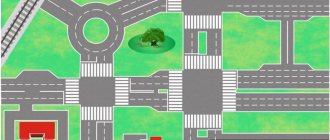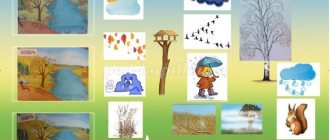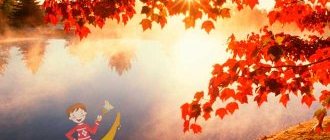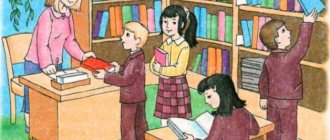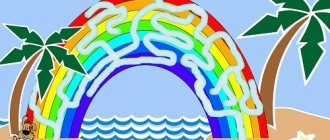Ecological quiz for preschoolers
From early childhood, every child needs to be told about what surrounds him, to instill an interest and love for nature. By answering quiz questions, a preschooler learns to think logically, develops memory and imagination, and increases his vocabulary.
MAGAZINE Preschooler.RF
Summary of the environmental quiz “Young Nature Experts”(for children of the preparatory group)
Conducted and prepared by the teacher: Potapycheva Natalya Gennadievna, State budgetary preschool educational institution kindergarten No. 29 of the Petrodvortsovo district of St. Petersburg
Target:
- Expand children's horizons with information about the life of animals, birds, and plants.
- Reinforce the rules of behavior in nature.
Program content:
Educational objectives:
- Enrich the personal experience of a child’s positive, humane interaction with nature. Expand environmentally valuable contacts of children with plants and animals, objects of inanimate nature.
- Strengthen the cognitive interest of love for nature, as well as aesthetic feelings.
Educational tasks:
- Cultivate a caring attitude towards your native land.
- Foster love and respect for nature.
- Foster a sense of friendship and mutual assistance.
- Expand children's horizons with information about the life of animals, birds, and plants.
- Reinforce the rules of behavior in nature.
Developmental tasks:
- Develop speech, attention, memory.
- Develop children's creative abilities.
Preliminary work.
- View the presentation "nature"
- Memorizing poems, proverbs, asking riddles about nature and weather;
- Conversations with children about endangered animals and plants that are listed in the Red Book;
- We held a competition of advertising posters “Do not harm nature” ;
- Board and educational games about nature and weather:
- "Edible and Inedible";
- "Field, forest, vegetable garden";
- "Fishermen and Fishes";
- Lotto "Domestic and wild animals" .
- Consideration of the encyclopedia “Animals and Plants of Our Nature”
- Watching videos about nature;
- Observation while walking.
- Learning movements and songs.
Objectives by educational areas:
NGO "Poznanie"
- Formation of an initial system of value orientations (perception of oneself as a part of nature, the relationship between man and nature).
- Formation of initial skills and habits of environmentally literate behavior that is safe for nature and for the child himself.
NGO "Communication"
- develop the ability to think logically, draw conclusions, inferences, develop communication skills;
- activate your vocabulary with new words
- teach team members to act together
NGO "Health"
- To form in children the concept that “tearing plants is not allowed” , we can thereby cause harm to the surrounding nature, and therefore to ourselves. After all, man is a part of nature.
OO "Trud"
- develop a desire to work, to make your contribution to the cleansing of our planet from human waste products (garbage collection).
NGO "Music"
- bring children joy and pleasure from joint dance compositions.
Material:
- multimedia equipment
- plant seed kits;
- globe;
- record player
- animal costumes;
- cards.
Quiz progress:
The children enter the hall to the music. They take out tokens of 2 different colors and sit down according to the color of the token.
Leading:
- Hello, dear guys! Today we have gathered to hold an environmental quiz . ” Our quiz involves two teams.
I will ask the teams to come up with names for their teams.
1 team...
2nd team...
— Please greet the teams with loud applause.
Leading:
I hugged the globe. One over land and water. In my hands the continents quietly whisper to me: “Take care .
The forest and valley are painted green. They tell me: “Be kind to us . Don’t trample us, don’t burn us, take care of us in winter and summer.”
A deep river gurgles, caressing its banks, and I hear the voice of the river: “Take care of us, take care of us .
I hear everyone from both birds and fish: “We ask you, man. Promise us and don't lie. Take care of us like an older brother.”
So that the flowers bloom in the forest, We will not collect large bouquets of them all spring and summer.
If the chick flies out of the nest before its time, We will help, no problem, Don’t crack, magpie.
Even though the fly agaric is harmful, we will not touch it. Suddenly the Forest Dweller needs him.
The fragile house of the ant must also be protected. He must definitely stand behind the fence.
Bunny and hedgehog - Forest dwellers You better not touch! Keep them safe! Let's protect nature, preschoolers!
We must not forget about her for a minute. After all, flowers, forests, fields and rivers, This is all for us forever!
— Our planet is like a big and beautiful house
“She delights us with gentle morning sunrises, colorful farewell sunsets, and landscapes of our native nature.”
— It fascinates us with its huge, deep and endless oceans, the expanses of the seas
— Surprising with high mountains, large slopes and hills
— Admires the dense, fragrant groves, pine forests, mighty oak forests
— Earth is a planet of harmony. Everything on it is proportionate and interconnected
— The nature of the planet is perfect
— Guys, do you see how beautiful the nature of our planet Earth is? Now let’s check what you know about the nature of planet Earth.
Competition “Find the correct answer” Envelope No. 1
(task explanation)
— There are pictures of seeds on the tray, look at them. Tell me, what plant does this seed come from? For the correct answer, the team receives a token. Time has passed!
(seeds: pumpkin, cucumber, sunflower seeds, watermelon, apple, cherry, persimmon)
Competition "What's extra?" Envelope No. 2
- I’ll ask you to open the envelope. Carefully look at the pictures and answer the question what is superfluous and why do you think so?
- Whoever answers the fastest and correctly will receive the coveted token.
Competition “Recognize by silhouette” Envelope No. 3
Host: Now let’s check how much you know the animal world.
Look carefully at the picture, all the animals are mixed up. You must name all the animals that are depicted here.
— Whoever answers the fastest and correctly will receive the coveted token
Musical break “The deer has a big house”
Competition "Forest Theater" No. 4
(task explanation)
Leading:
— Once a fox, a hare and a bear met in a forest clearing. And they began to tell each other about their animal lives. Listen to the story and say what is true and what is not true.
Fox:
“I live well in the forest, every bush is my home.” I only like to eat berries and plant roots.
Hare:
- My house is small and cozy. I keep it clean and tidy. I wash the windows all day, clean them and sweep away the dust.
Bear:
“And I went to the anthill, stuck my paw in and started licking it - it was very tasty.” And then he went to the river to catch fish.
Fox:
- Yes, Mishenka, I love fish myself. I breed it in my pond, feed it and grow it.
Bear:
- It’s not easy for me in the spring. I've lost weight over the winter and my appetite is good. Now I’m going to go collect acorns and the first mushrooms in the thawed patches.
Hare:
“You’re all talking to yourself, talking to yourself, and I’m taking care of my bunnies all day.” I sit and do not leave the nest, protecting my children with my breasts.
(summarizing and distributing tokens for correct answers)
Competition "Lost" Envelope No. 5
Host: Look carefully at the picture and quickly name who lost what?
Competition “Answer correctly” No. 6
Presenter: There is a poster on the board with a picture of a bird’s beak and paws. I will name the bird, and you must find the beak (paws) of the bird that I name.
Competition “Fold the picture” No. 7
— Whoever answers the fastest and correctly will receive the coveted token
Presenter: There are geometric shapes in front of you, you need to make a picture from them
- Whoever quickly and correctly draws a picture will receive the coveted token.
Leading:
Love your native nature. Lakes, forests and fields. After all, this is our forever native land.
You and I were born on it, you and I live on it. So let us, people, all together We treat her kinder.
Leading:
— Our quiz has come to an end. Let's see whose team won?
(awarding prizes to teams)
On the board is a poster with a picture of a beak: (a) - woodpecker, (b) - crane, (c) - parrot, (d) - duck, (e) - hawk, (f) - sparrow.
A duck's (a) legs are adapted for swimming, a parrot's (b) for climbing trees, an eagle's (c) for capturing prey, and a pigeon's (d) for walking on the ground.
| Next > |
GCD summary. Ecological quiz “Nature connoisseurs”
Tasks:
• Summarize children's knowledge about animals, plants, seasons, and nature conservation. • Develop logical thinking and speech. • Activate attention and memory. • Teach children to follow the rules of the game. • Develop the ability to listen carefully to the teacher and peers, develop a sense of responsibility to your team, and the ability to work together. • Foster a caring attitude towards nature.
Preliminary work:
Before the start of the lesson, the children of the group are divided into two teams. Children decide what they will name their teams, choose captains, and discuss emblems. Getting acquainted with the Red Book, reading the works of M.M. Prishvin, looking at illustrations about nature.
Progress of the lesson:
The teams enter the hall to the music. They take their seats at tables with pre-prepared emblems. A small number of children participate in the quiz; all children sit at tables, hold hands and close their eyes for 1 minute (psychological mood). — To conduct our environmental quiz “Nature Experts” you will need a fair jury; the presenter offers to choose a jury from among the guests. - ATTENTION! ATTENTION! Let's start our environmental quiz: “Nature Connoisseurs”.
Let's remember the rules of our game:
You cannot give hints to teams during the game and interrupt your comrades. Only those who raised the flag first can answer questions. For each correct answer, the respondent receives a point. The one who scores the most points at the end of the quiz is the winner. If the team answering the question finds it difficult or gives the wrong answer, then the other team, that is, the opponents, answers. You need to be very careful and patient. Pay attention to the table in front of you, there is a top prepared on it, with an arrow, the arrow will indicate which team will have to answer first. And so we begin!
Leading:
There is a wonderful world - it’s all around And you just have to want How nature will suddenly come to life And everyone will want to fly like a bird The sound of a curly birch tree in the forest And I invite you to plunge into nature, into the wild world and beauty.
Presentation 1. (Appendix No. 1).
Slide 1. Our quiz will be held under the title “Nature Experts”. Slide 2. Our planet is like a big beautiful house. Slide 3. She pleases us with morning, gentle sunrises, colorful farewell sunsets, landscapes of our native nature; Slide 4. It fascinates us with its huge, deep and endless oceans and expanses of seas. Slide 5. It surprises with high mountains, steep cliffs and hills, Slide 6. It delights with dense, fragrant groves, pine forests, and mighty oak forests. Slide 7. Earth is a planet of harmony. Everything on it is proportionate and interconnected. Slide 8. The nature of the planet is perfect. Our Earth has been called a mysterious planet and mysterious. Slide 9. However, for sensitive hearts she reveals her deepest secrets. We learn and explain natural phenomena, the secret of the birth of a new day, the diverse world of living and nonliving things on the planet. Slide 10. It’s up to you, our future generation, to keep the planet as beautiful as it is.
I – Greetings of teams.
Greetings from the “Pure Spring” team
The expanses of the beloved Motherland are wide, Every bush and moth is precious. Let us preserve the beauty of nature, Let the “Pure fontanelle” murmur and sparkle!
Greetings from the Forest Defenders team
If there is a lot of forest, don’t destroy it, If there is a little forest, take care of it, If there is no forest, plant it. We plant and grow the forest, we will protect it, we will not give offense to anyone.
II Warm-up. With children “It happens - it doesn’t happen”
Ice drift in summer (doesn't happen) Leaf fall in summer (doesn't happen) Rain in summer (doesn't happen) Dew in winter (doesn't happen) Frost in spring (doesn't happen) Thunderstorm in summer (doesn't happen) Snowstorm in summer (doesn't happen) Rainbow in summer (doesn't happen) Hail in summer (doesn't happen) Buran in summer (doesn't happen) Frost in winter (doesn't happen) Fog in autumn (doesn't happen) Drops in summer (doesn't happen) Frost in summer (doesn't happen) Frost in summer (doesn't happen) Puddles in winter (doesn't happen)
III "Assemble the puzzle"
Children are offered cut-out puzzle pictures. The team that is judged is the one that completes the puzzle faster and tells what is depicted there.
IV. "Question and answer"
1. The longest necked animal. (Giraffe) 2. Who carries the baby in the bag? (Kangaroo) 3. A bird that cannot fly and is not afraid of frost? (Penguin) 4. Long-eared coward. (Hare) 5. Who sleeps upside down? (Bat) 6. Which snake has a hood? (Cobra) 7. Which bird does not build a nest? (Cuckoo) 8. The largest animal living on land. (Elephant) 9. The largest animal living in the ocean. (Whale) 10. What animal builds dams on rivers? (Beaver) 11. Who carries his house on himself? (Turtle, snail) 12. Which bird has the most beautiful tail? (The peacock) 13. A striped relative of the cat. (Tiger) 14. What animal is called the ship of the desert? (Camel)
V. Outdoor game “Swamp”.
Draw two lines from one another at a distance of 7–10 steps. Between them, 10-12 circles are drawn with chalk at a distance of 25-30 cm from each other - these are hummocks, and the circle is a swamp (you can draw a line). The players' task is to move over the hummocks from one bank (line) to the other. Children take turns jumping on both legs from hummock to hummock. Anyone who jumps past a hummock into a swamp gets his feet wet and leaves the game (dries out on the shore). The winners are those who make it safely from shore to shore.
VI. "Mystery box": a riddle about bread.
At first I grew up free in the field, In the summer I blossomed and made ears, And when I threshed, I suddenly turned into grain. From grain to flour and dough. I took a place in the store.
VII. – Choose the right behavior in the forest
Presentation 1. (Appendix No. 1 continued).
Don’t break branches, don’t mutilate trees, don’t tear up a blade of grass or a leaf in vain. You can play in the forest: tear leaves, weave wreaths, collect huge bouquets. Just think, there are already a lot of them in the forest. Finally, you can make noise, shout, run, and most importantly, you won’t bother anyone! Try not to make noise, otherwise the forest will be afraid, hide, and you will not learn a single secret. A bug-eyed frog, a creeping snake, a clumsy toad, and nasty caterpillars can be driven away, but it would be better if they were not there at all. All kinds of animals are important - all kinds of animals are needed. Each of them does their own good for nature. Plant as many trees as possible so that we can breathe clean air. When relaxing in the forest, do not remove garbage from the grass, but leave it there. Now put nature protection signs where children do wrong (the rule is accompanied by a picture).
VIII. Literary break: children read poems about nature (Appendix No. 2).
Summing up, announcing the overall score. Rewarding.
- Dear Guys! I was very pleased that you took part in our environmental quiz “Nature Experts”. I hope that you will love nature even more, show interest, and protect it. And now, guys, let’s stand in a semicircle and perform “Hymn to Nature” “Home Earth”
Wise nature teaches us at any time of the year. Birds teach us to sing, Spiders teach us patience, Bees in the field and in the garden teach us how to work. Snow teaches us purity, Teaches the sun kindness. You need to learn from nature all year round. After all, her forest people teach strong friendship.
Appendix No. 2. Poems.
What is a forest? What is a forest? Pines to the skies, Birches and oaks, Berries, mushrooms... Animal paths, Hills and lowlands, Soft grass, An owl to bitch. Silver lily of the valley, clean, clean air and a spring with living spring water.
What is a meadow? What is a meadow? A carpet of grass all around. Decorative corollas of flowers, sonorous grasshoppers. Moths are playful, Beetles are leisurely. With the sweet honey of the bee, the song of the quail. Mint aroma, Summer's gentle look And to the white flies With a shepherd's pipe.
What is a field? What is a field? For horses there is freedom, a strip of arable land, panicles of oats. Ripe wheat is earing in the field And the rye is rustling there, prickly like a hedgehog. The wind whistles in the field, the mouse is looking for grain, the lizard is scurrying about, the sun is rising. Only the bird knows where its border is, but you go - you won’t find the edge. What is a river? What is a river? Clouds on the water. There are willows above the water. Spring floods. Perch, ruff. Water lilies, reeds. Foam on the sand, Boat in the distance. There is a duckling in the nest, and a beaver in the house. There's a crayfish under a snag, There's a fisherman on the shore.
What is a garden? What is a garden? Pink outfit. Apple trees are blooming, Birdhouses are singing. Blue drops, swing balls. Rose hips, Gooseberries. Golden pears, fluffy peaches. The rustle of falling leaves, the autumn coolness. Bullfinch family, Favorite bench.
What is a vegetable garden? What is a vegetable garden? Round dance of vegetables. Melons are sweet, Tomatoes are smooth. With strawberry beds, rakes and shovels. Watering can with rain. Snail under a leaf. And underground a mole made a move. Just for the sake of order, Watchman Vanyatka is an angry scarecrow stuffed with straw.
What is the sea! What is the sea? Seagulls in the open air. Giant rocks, Cold fogs. Three-story waves, brave sailors. Sharks are toothy, whales are big-headed. Lumps of underwater stones, strange fish. Corals, octopuses, Jellyfish and lampreys, And the bottom is dark, Like in the movies...
What are mountains? What are mountains? Talking with the wind. Snowy peaks, menacing avalanches. The paths are rocky, the antelopes are fast, the abysses are bottomless and the caves are dark. Thorn bushes, Snakes and lichens, Climbing goats, And diamonds underground. Rivers are like crystal, In the blue haze of the distance, Where the eagle soars - Guardian of the high mountains.
Appendix No. 1. Presentation
Author: Rodionova Natalya Sergeevna, teacher, preschool educational institution “Svetlyachok”, Khvalynsk, Saratov region, Russia
The article is published in the author's edition
